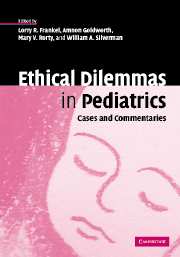Book contents
- Frontmatter
- Contents
- List of contributors
- Preface
- Introduction
- Part I Therapeutic misalliances
- Part II Medical futility
- Part III Life by any means
- 7.1 Where should a child die?
- 7.2 Where should a child (in the USA) die?
- 7.3 Topical discussion
- 8.1 Infant heart transplantation and hypoplastic left heart syndrome: what are the ethical issues?
- 8.2 Infant heart transplantation and hypoplastic left heart syndrome: a response
- 8.3 Topical discussion
- 9.1 Liver and intestinal transplantation
- 9.2 Transplantation and adolescents
- 9.3 Topical discussion
- Part IV Institutional impediments to ethical action
- References
- Index
- References
7.1 - Where should a child die?
Published online by Cambridge University Press: 18 August 2009
- Frontmatter
- Contents
- List of contributors
- Preface
- Introduction
- Part I Therapeutic misalliances
- Part II Medical futility
- Part III Life by any means
- 7.1 Where should a child die?
- 7.2 Where should a child (in the USA) die?
- 7.3 Topical discussion
- 8.1 Infant heart transplantation and hypoplastic left heart syndrome: what are the ethical issues?
- 8.2 Infant heart transplantation and hypoplastic left heart syndrome: a response
- 8.3 Topical discussion
- 9.1 Liver and intestinal transplantation
- 9.2 Transplantation and adolescents
- 9.3 Topical discussion
- Part IV Institutional impediments to ethical action
- References
- Index
- References
Summary
Introduction
The case to be discussed concerns the course of illness of William, which began at birth and continued until his death at 13 years of age. What is significant are the values of the caregivers and the family that led them to acknowledge the need for restraint in the care of this child. These attitudes are specifically discussed in answering the following three questions: Who decides? What are the aims of treatment? Where to die?
The case
William was born on August 17, 1984. He was his mother's sixth child. The following year his mother had twin girls. Apart from William all the children were, and are, healthy. A few hours after a normal birth William was noticed to be cyanosed and unwell. He was admitted to the neonatal intensive care unit where he was found to have a complex form of congenital heart disease with hypoplastic ventricles and pulmonary hypertension. A Blalock shunt, which is a palliative procedure, was performed successfully, though he subsequently required a balloon atreal septoplasty.
From the start it was recognized that he had a rather poor prognosis. At the earliest stage this was discussed with the parents by the cardiologist, who offered an opinion that
William's short-term outlook is relatively good. His long-term outlook depends on whether his relatively underdeveloped left ventricle will grow. If not, then he becomes effectively a univentricular heart of the right ventricular type. They tend, unfortunately, to develop significant problems with heart failure in their teens or early twenties. […]
- Type
- Chapter
- Information
- Ethical Dilemmas in PediatricsCases and Commentaries, pp. 157 - 161Publisher: Cambridge University PressPrint publication year: 2005



